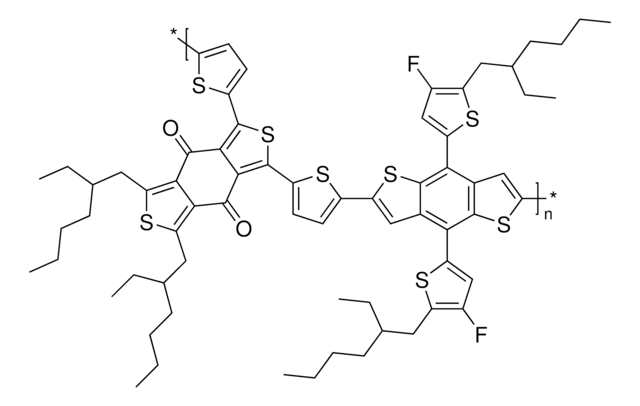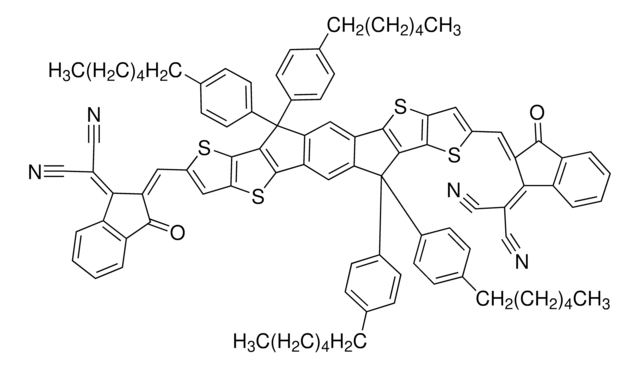Kluczowe dokumenty
About This Item
Polecane produkty
opis
Band gap: 1.68 eV
Poziom jakości
Próba
97%
Formularz
solid
rozpuszczalność
chloroform: soluble
dichlorobenzene: soluble
Energia orbitalna
HOMO -5.58 eV
LUMO -3.9 eV
ciąg SMILES
S1\C(=C/c2c3n[s]nc3c(cc2)c4[s]c5c(c4)C(c6c5cc7c(c6)c8[s]c(cc8C7(CC(CCCC)CC)CC(CCCC)CC)c9c%10n[s]nc%10c(cc9)\C=C%11/SC(=S)N(C/%11=O)CC)(CC(CCCC)CC)CC(CCCC)CC)\C(=O)N(C1=S)CC
InChI
1S/C72H88N6O2S8/c1-11-21-25-43(15-5)39-71(40-44(16-6)26-22-12-2)53-35-52-54(36-51(53)65-55(71)37-57(83-65)49-31-29-47(61-63(49)75-87-73-61)33-59-67(79)77(19-9)69(81)85-59)72(41-45(17-7)27-23-13-3,42-46(18-8)28-24-14-4)56-38-58(84-66(52)56)50-32-30-48(62-6
Klucz InChI
HKJHYTKBDDVGRK-IOUDQCQMSA-N
Powiązane kategorie
Zastosowanie
Kod klasy składowania
11 - Combustible Solids
Klasa zagrożenia wodnego (WGK)
WGK 3
Temperatura zapłonu (°F)
Not applicable
Temperatura zapłonu (°C)
Not applicable
Wybierz jedną z najnowszych wersji:
Certyfikaty analizy (CoA)
Nie widzisz odpowiedniej wersji?
Jeśli potrzebujesz konkretnej wersji, możesz wyszukać konkretny certyfikat według numeru partii lub serii.
Masz już ten produkt?
Dokumenty związane z niedawno zakupionymi produktami zostały zamieszczone w Bibliotece dokumentów.
Produkty
The emerging organic photovoltaic (OPV) technology is very promising for low-cost solar energy production. OPV devices can be produced using high-throughput, large-volume printing methods on lightweight and flexible plastic substrates, making them easy to deploy and use in innovative ways.
The emerging organic photovoltaic (OPV) technology is very promising for low-cost solar energy production.
Professor Chen (Nankai University, China) and his team explain the strategies behind their recent record-breaking organic solar cells, reaching a power conversion efficiency of 17.3%.
Global Trade Item Number
| SKU | GTIN |
|---|---|
| 900853-100MG | 4061832939964 |
| 900853-50MG | 4061832939971 |
Nasz zespół naukowców ma doświadczenie we wszystkich obszarach badań, w tym w naukach przyrodniczych, materiałoznawstwie, syntezie chemicznej, chromatografii, analityce i wielu innych dziedzinach.
Skontaktuj się z zespołem ds. pomocy technicznej







